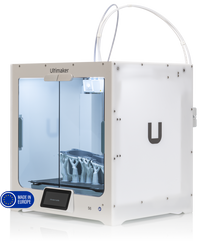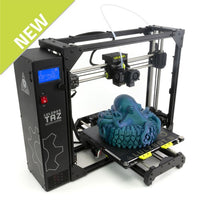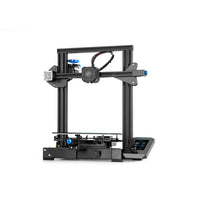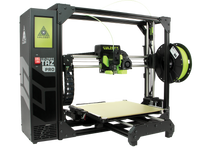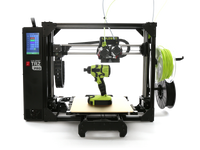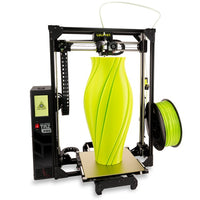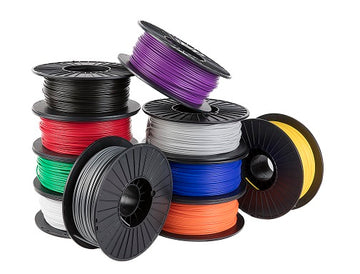Everything you need to know about nozzles for 3D printing
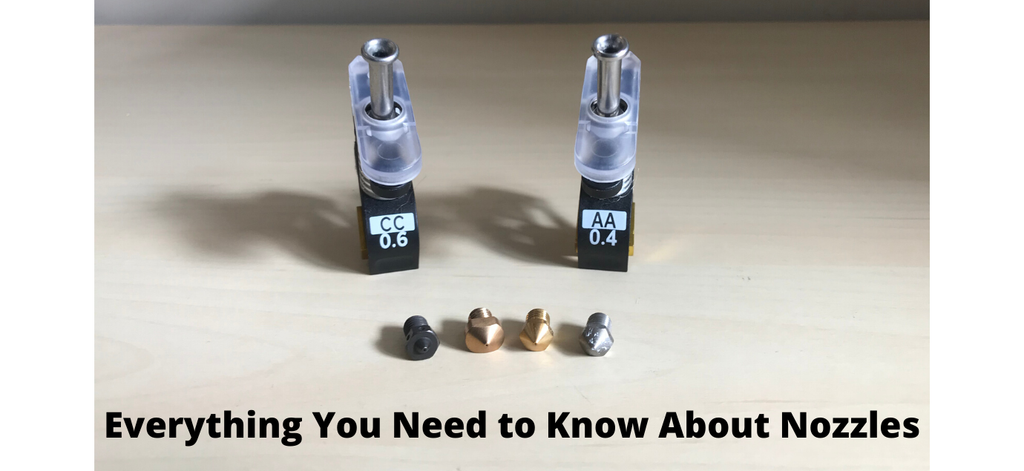
3D printing is a disruptive manufacturing technology currently being used by professionals, students and hobbyists around the world. In order to fully leverage this technology it is important to understand how these machines work and how to optimally set up your printer to achieve your desired outcome. When it comes to slicing software, there are literally hundreds of different settings. This guide is designed to help you better understand one small aspect of those settings, nozzles.
One of the most overlooked aspects of the entire printing process is the nozzle size and type. Yes, you read it right. Nozzles really are important when it comes to achieving a consistent output. Apart from other advantages, the nozzle also determines the print quality, printing time and even the strength of the print.
Here through this article, we will explain how nozzles size and type affect the print and how to choose the perfect nozzle for your 3D printing needs.
UNDERSTANDING 3D PRINTER NOZZLES
Of all the components in a 3D printer, the nozzle is the last part of the machine that extrudes the melted filament and helps the material to be deposited onto the build platform in the required geometry.
While every nozzle serves this purpose, not every nozzle can perform this function in the same way. Nozzles are available in multiple sizes, materials, each having their own pros and cons. These sizes and materials determine (as mentioned earlier) the print quality, printing time, and strength of the 3D print. And so the nozzle becomes a crucial element in the 3D printer which should be selected with caution.
Let us now study the different types of nozzles available in the market today.
3D PRINTER NOZZLES
While a lot of settings can be controlled through a slicer software, for users looking to churn out as much performance from their printer a possible, nozzle swapping is the fastest and cheapest way to do so.
As already established, nozzles are important and so is selecting the right nozzle for your specific print. This selection must be done with a proper understanding of its advantages and disadvantages. Choosing the right nozzle can go a long way in bettering the overall 3D printing experience.
But it is important to know the difference between nozzles and how different nozzles can be used effectively to positively impact the print quality. The important attributes of a 3D printer nozzle are its size and material and we will focus our article on the same.
First, let's cover how to choose the size of your nozzle.
When to Choose Small Size Nozzles
- Minute Features: Small nozzles should be used while printing highly detailed models. Smaller nozzles extrude material in a finer volume and this helps in printing with finer resolution. Finer resolution means minute features on the design can be efficiently captured in the print. So, for a print having minute features, a smaller nozzle is recommended.
- No Time Constraint: A small nozzle diameter means a lower flow rate of material through the nozzle and this means that the printing speed will be considerably slower. So, when time is not a constraint for a print, then smaller nozzles can be used effectively.
- Artistic Objects: It makes sense to print artistic of highly featured objects with a smaller nozzle because that is where the nozzle truly becomes effective. 3D printing a plain object like square, rectangle, etc. will only result in a longer printing time with almost no appreciable difference in the object.
- Lower Layer Height: It is recommended that the layer height should not exceed 80% of the nozzle diameter. So, if the nozzle diameter is 0.2mm then the maximum layer height should be 1.6mm. Thus a smaller nozzle means a lower layer height.
- Easy to Remove Supports: Support structures are inherently under-extruded and by purposely using smaller nozzles the support structures will be thinner so that they can be easily removed at the end of the print.
- Avoid Abrasive Filaments: Use of small nozzles should be avoided in case of printing with abrasive filaments like metal-fill, glass-fill, wood-fill, etc., filaments as the large particles in these filaments can clog the small nozzle easily.
- Applications: Small nozzles can be used to print applications like jewelry, text printing, miniatures, and other finer detailed objects.
When to Choose Large Size Nozzles
- Faster Printing: A large nozzle diameter will naturally result in a larger flow rate through the nozzle and thus more material will be deposited. This ultimately means that the objects will be printed faster.
- Increased Layer Height: As explained earlier, the larger diameter will mean an increased layer height. So, a nozzle of 0.8mm diameter will have a maximum layer height of 0.64mm.
- Better Mechanical Properties: It is tested (by Prusa Research) that objects printing with a larger nozzle tend to have an increased toughness. These objects have a higher impact absorption capability than the objects printed with smaller nozzles. As per the Prusa test, the objects printed with the 0.6mm nozzle absorbed up to 25% more energy than those printed with a 0.4mm nozzle.
- Abrasive Filaments: Larger diameter nozzle can be effectively used for printing with abrasive filaments as they generally do not clog and even if they do then a larger nozzle is easy to unclog than a small nozzle. So, you are always better off with a large nozzle when printing with abrasive filaments. Keep in mind you will also want this to be made in certain materials which we will go over in more details later on.
- Lower Print Resolution: Since large nozzles extrude thicker lines of material, they are not the ideal choice for thin, fine features. So, large nozzles are suitable where finer details are either absent or are not so important.
- Applications: Large nozzles can be used to print large objects, low detailed objects, objects that need not be aesthetically appealing and specific objects that need to have better strength properties.
3D PRINTER NOZZLE SIZES

Gif shows the printing time taken by different nozzle sizes (Left: 0.25 mm nozzle takes 24 hours 40 minutes to print the object, Right: 0.6 mm nozzle takes 5 hours 50 minutes to print the object)
3D printer nozzles are available in many sizes ranging from 0.1 mm up to 1.2 mm but even bigger nozzles are found on some very large format 3D printers. Let us explore some of them to understand the features, benefits, and limitations of small and large size nozzles.
Popular Nozzle Sizes
- Nozzle Size: 0.1 mm
This is the smallest nozzle found on FDM 3D printers. It is not so commonly used and primarily because it is difficult to work with. It is important to understand that a smaller nozzle will deposit less material and so the printing time will also increase.
But as an advantage, a smaller deposition also means that finer details can be captured more easily. A 0.1mm nozzle can print incredibly fine features. However, nozzles with this small of diameter can be prone to clogging and ensuring proper flow settings in your slicer is critical.
- Nozzle Size: 0.25 mm
This is a more popular nozzle size for 3D printer users looking to print fine features. This is the smallest nozzle size you can find from the LulzBot tool heads for example in their SL Tool Head 0.25mm Micro. Again, since this is closer to the minimum size mark, the nozzle gives good quality output with a comparatively higher deposition rate than a 0.1mm. However, you still want to avoid using any sort of composite and filled material with a nozzle size this small as this will be prone to clogging. Not all materials can be 3D printed with nozzles this small so be sure to check with the filament manufacturer prior to printing.
- Nozzle Size: 0.4 mm
This is probably the most commonly used nozzle by all users. It is the default size for the print cores fitted on all Ultimaker 3D printers out of the box. It gives a great balance between good quality and speed of printing. This nozzle lies close to the middle of the nozzle size range and so the print quality is obvious. This size will have no problem printing most standard materials like PLA, ABS, PETG, but can be problematic for composite materials. For this reason, we suggest using a 0.5mm nozzle or larger for printing wth our Woodfill filament for example.
- Nozzle Size: 0.8 mm+
Lastly, a 0.8 mm nozzle prints at impressive speeds and the printing can be completed quickly. But as the speeds increase, the quality can be reduced as this is not a good selection for parts with fine features. It cannot capture the finer details of design and so it is only used when the model does not have any minute features and the quality can be compromised for speed. This is a nozzle that every user should have when they want to print fast. 0.8mm is the largest size Ultimaker has available in both their AA and BB print cores. Some users will look to nozzles larger than this size, but we won't cover each of those in detail.
3D PRINTER NOZZLE MATERIAL

Different types of nozzle materials (from left to right) brass, hardened steel, stainless steel, and ruby tip/Courtesy: Filament2Print
As we learned about the nozzle sizes, we now will learn about the nozzle materials. The nozzle material can determine the filament that can be used for printing purposes.
- Brass 3D Printer Nozzle

Brass 3D printer nozzle/Courtesy: Ultimaker
A brass 3D printer nozzle is the most common nozzle on all FDM printers. It is the standardized option provided by almost all manufacturers. The main reason for its popularity is the low cost and it is easy to machine for the manufacturer. It also provides good thermal conductivity and stability. Brass, though being the most common, is limited by the type of filaments it can handle.

Wear caused by abrasive filaments on a regular brass nozzle/Courtesy: Ultimaker
Brass nozzles are perfect for printing with non-abrasive filaments like PLA, ABS, Nylon, PETG, TPU, and others.
However, they wear rapidly when used with abrasive filaments like carbon fiber, metal-filed, or glass fiber filaments. This will cause the print quality to deteriorate over time.
So, only non-abrasive materials should be printed with brass nozzles to ensure a consistent output over a longer lifetime.
- Hardened Steel 3D Printer Nozzle

LulzBot HS 0.8mm Tool Head/Courtesy: LulzBot
One of the problems with brass nozzles is their durability. Brass nozzles wear rapidly when printing abrasive materials and this affects the print quality. This problem can be easily solved by using hardened steel nozzles as they are about 10 times more wear-resistant. Apart from the advantages, the nozzle also exhibits some disadvantages like lower heat transmission and the possible presence of lead. The lead makes it useless for printing products coming in contact with skin and/or food. The lower heat transmission means they generally require higher printing temperatures than brass when printing the same materials.
So, users who print with abrasive materials like carbon fiber, glass fiber, metal-filed filaments like steel-filled, iron-filled, brass-filled and other exotic filaments should use this nozzle.
Multiple hardened steel nozzles are available in the market but LulzBot HS-Series Tool Head stands out from the competition. It has a nozzle diameter of 1.2 mm thus allowing faster printing speeds and also imparting better strength to the printed parts. It enables 3D printing of industrial-grade composites, such as carbon fiber or glass fiber-filled polyamide (nylon) for high-strength 3D prints. Interestingly, this printhead is capable of printing composites with a tensile strength yield comparable to PEEK
- Stainless Steel 3D Printer Nozzle

Stainless steel 3D printer nozzle/Courtesy: E3D
Stainless steel 3D printer nozzles are also quite popular, especially because it can be used with light abrasive materials. Additionally, since a stainless steel nozzles are lead-free, the nozzle cannot contaminate the printing materials and thus can be used for products that come in contact with skin and/or food. For 3D printing, any FDA approved product the nozzle has to be lead-free and stainless steel could be considered an option.
- Ruby Tip 3D Printer Nozzle

Ultimaker Ruby Tip 0.6 CC Red print core/Courtesy: Ultimaker
This is a hybrid nozzle made from a brass body but a ruby tip. The ruby tip increases the durability of the nozzle while the brass body helps in providing good thermal conductivity and stability. It provides almost an infinite durability and superior printing precision than any other nozzle type.
The only drawback of the nozzle is that it is very expensive for regular users.
If any Ultimaker users are considering buying a ruby tip nozzle then the Ultimaker 0.6 CC Red is the perfect option as it is specifically designed to withstand abrasive filaments and precision-machined 0.6 mm nozzle diameter. Its quick-swap design maximizes uptime with no tooling or manual calibration needed.
In addition to the above differentiation, make a note of the below points for added input while choosing a nozzle.
- For conventional materials like PLA or ABS, brass nozzles can be used with ease and a nozzle of 0.4 mm to 0.6 mm are most common.
- For abrasive materials containing fibers like Carbon fiber, etc., hardened steel nozzles should be used with a diameter greater than 0.4 mm to avoid nozzle clogging.
NOZZLE SELECTION

Larger the nozzle, faster the print and smaller the nozzle finer the quality of print/Courtesy: LulzBot
Now that we have presented the difference between the various nozzles and how they affect the print quality, we believe users can now choose a suitable 3D printer nozzle according to their needs. The main distinction is between small and large nozzles, and the material in which the nozzles are made.
CONCLUSION
We believe you will now be able to effectively choose between the different types of nozzles available, and understand why to choose a specific one. There is not one perfect nozzle, but instead, a best option for a given application or print based on the detail requirements, time available for printing, and the material being selected. If you have any questions about how to select the best nozzle for your application, feel free to contact us today.
See the 3D printers we offer
Read our other articles

